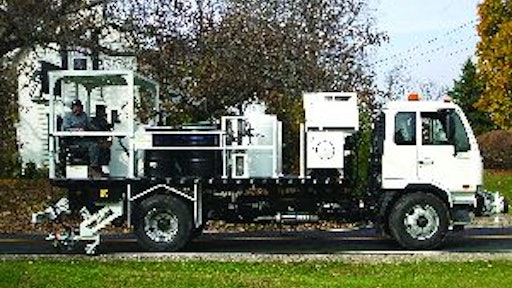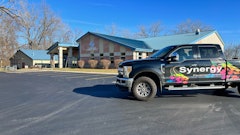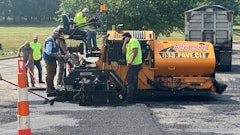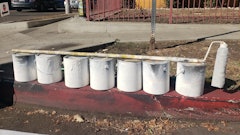
So you want to stripe roads? Get out your pencil and paper and jot down these questions to ask yourself before approaching an equipment dealer. What kind of projects am I going to target? Who is the primary customer? Do I plan to start out with small roads and projects and then grow into the highway marking market? What can I afford?
The questions, of course, are interrelated. Affordability, for example, is directly related to revenue and the type of market and customer you're targeting. It wouldn't be feasible to purchase a large, dedicated truck-mounted striper that costs anywhere from $100,000 and up and then try to make payments striping temporary roads, highway exits, and small municipality roads. Purchasing a small pallet-mounted striper to go after the highway market where putting down between 150,000 and 200,000 linear feet of striping per day may be the norm wouldn't make sense from a productivity point of view either - not to mention trying to meet specification requirements that highway departments may mandate.
"Before buying a striper, you have to know who the customer is and what that customer wants," says Steve Muellenbach, vice president and general manager of M-B Companies Inc. "Generally speaking, however, if you're looking for versatility, to be able to stripe both smaller and larger projects, I would suggest buying a truck-mounted unit. It gives the operator more capacity than a pallet unit and having two operators on the back allows the driver to concentrate on driving."
M-B Companies manufactures both palletized and truck-mounted stripers, including Model 155 airless and Model 320 air spray pallet units and the Advantage 500 truck-mounted paint striper. "A neat option on our truck-mounted unit is a data acquisition system," says Muellenbach. "The system monitors speed, number of glass beads used, and how many feet of paint were put down at what speed, among other data. It's great for inventory control and for keeping the job with specifications."
MRL Equipment Co. also offers only small truck-mounted stripers. Its compact models 1-90 and 1-260 have many of the same features found on much larger stripers. "If the buyer has limited funds and his jobs are modest in size, a palletized unit will work," says company Vice President of Sales and Marketing Steve Shinners. "They are far less expensive. However, many users report that using a pickup-mounted unit has its limitations. A pickup is more difficult to drive because of the longer front end compared to a typical truck-mounted striper, which is mounted on a cab over or cab forward style truck. 'Drive ability' can affect quality of the lines applied to the road. "
Know Your Market
Shinners poses these considerations for anyone in the market for a truck-mounted striper. "Anyone going into a truck-mounted striper in all likelihood will be working as a sub or prime contractor for a city, county, or state government agency. This brings into play a whole list of requirements: Do you need to be pre-qualified? Do you need to be certified? Does your equipment need to be certified? Will your workers need to be certified by an outside organization such as the American Traffic Safety Services Association (ATSSA)? Will the material you'll be using, i.e., paint and beads, require certification or pre-testing by the state's material lab? Do you have the capability of getting job bonding?
"This is just a partial list of considerations. Do your homework. None of the above items are all that difficult, but if not done correctly, a missed item or two can cost the new buyer of a truck-mounted striper a lot of grief and money."
Shinners notes that subcontractors need to do their homework on the prime contractor, too. "If you're working as a sub, do you understand how long it will take to get paid? Does the prime have a good reputation of paying on time? A typical response may be 'you get paid when the state pays me.' This can mean that several months may pass before you are paid for your work when your material supplier is demanding payments within 30 days or less. Cash flow can be tricky."
Pallet vs. Truck-mounted
"If you're just getting into the market, you likely won't want all the bells and whistles that can come with a striper or be as concerned about capacity and putting down 150,000 linear feet of edge lines a day," says John Hug, president of Hug Manufacturing. "Pallet-mounted stripers are ideal for contractors putting down temporary lines or working with municipalities on smaller striping projects. Since they can be removed from the truck, the vehicle can then be used for something else once the striping job has been completed."
Hug's company manufactures both pallet- and truck-mounted stripers. Among major differences, he notes that a truck-mounted striper is fabricated right into the bed and chassis assembly. It also has the capacity to do long-road striping, and these units are much more expensive than their pallet-mounted counterparts.
"If you're thinking about a pallet-mounted unit, you'll need at least a ¾-ton pickup with 8,800 lbs. GVW to accommodate the weight of the machine, not to mention the paint and beads," Hug explains. "One 55-gal. drum of paint weighs 750 lbs. and the beads will add another 350 lbs. Another nice feature about our pallet-mounted machines is their light weight, which leaves more capacity for paint.
"Before deciding on a machine or options, bring your employees into the buying process. We offer both air spray and airless systems and often the difference maker is an employee's comfort level and familiarity with a particular system. An air spray system employs a low pressure pump, less than 100 psi, to draw the paint from a tank and mix it with air. An airless system uses a high pressure pump to pull the paint from the tank and push it to the gun under high pressure, 800 to 1,200 psi. The high pressure atomizes the paint."
Hug names off several options to consider, as well. "A paint meter will track the amount of paint being put down, and for contractors who may do stencil work, a hand gun would be an important option to have." An intercom for two-person operation, hydraulic paint agitator, and a storage cart for the striper (when not in use) are available.
An affordable option to a pallet-mounted unit is a tow-behind striper that Graco has been producing since the mid 1990s. Called the RoadLazer, the unit directly competes with the palletized class of stripers and is designed for striping highway exits, temporary highway roads, airports, and other similar applications. "The fact that this unit is towable makes it very flexible," says Tim Wehner, worldwide business development manager for Graco. "It's easily unhitched from the pickup and being a tow unit, there's plenty of space in the truck bed to hold the material."
Options include a video guidance system, a hand-gun bead accessory, a multiple gun setup for painting yellow, white, and black lines, and an airless paint system. "There's no question that some operators prefer air spray and some airless, but when you look at the end product, lines produced by airless systems are much sharper," Wehner says. "Yes, a line is a line, and in some applications, having crisp stripes isn't mandatory. But if you want sharp lines, airless is the way to go."
"Which system you go with depends in part on your location," adds M-B's Muellenbach. "It may not seem logical, but as a general rule contractors east of the Mississippi prefer air spray and west of the Mississippi, airless."
Experience Counts
Kelly-Creswell manufactures airless and air spray paint stripers in pallet- and truck-mounted models. "The type of unit you buy depends on the experience of the operator, says Kelly-Creswell salesperson Don Hollon. "You can use a pallet-mounted unit with just one person, but it takes an experienced individual to be able to drive and stripe at the same time. You don't just get in the truck and become an efficient striper".
General manager Craig Treon has other suggestions for contractors looking to move up into the road striping market. "Make sure your striper has a footage counter. When putting down latex paint, look for a unit with stainless steel tanks and plumbing. The water used to wash out the system, along with the chemicals, can be very corrosive."
"Agitating the paint is very important, especially when striping. If you don't agitate the paint and keep it consistent, the lines will get wider as paint is drawn from closer to the bottom of the tank. Some manufacturers rectify this by offering linear actuators that raise and lower the gun to accommodate paint thickness, but these become another wear item," Treon adds.
"If I were a contractor looking to buy a pallet unit, I would consider using drums exclusively and not buying tanks. This saves money, upwards of several thousand dollars for a stainless steel tank, not to mention cleanup time."
Treon offers one more important tip for pallet unit buyers. "I advise customers to load the unit on a cab-over truck with a 15,000- to 17,000-lb. GVW. This truck offers more capacity than a pickup and better visibility to see the pointer. Sitting higher also allows the driver to keep the pointer closer to the truck and further away from traffic. A laser pointer is a nice option to consider."
As mentioned above, all the manufacturers offer an array of options for buyers, but as their spokespeople point out, when just getting into the market, the bells and whistles are less important than understanding the market and buying the right equipment to match it. "Contractors don't have to buy a brand new machine, either," MRL's Shinners reminds readers. "Many times we suggest a good used unit. The move is more affordable and gives the contractor an opportunity to test the market without a large investment."
Either way, you don't have to decide alone. Visit your dealer and even the manufacturer. "We invite customers in to sit down with our engineers and go through features and requirements step by step," Muellenbach says.
Once you know the target market, these requirements will be easily identifiable and help you determine the type and size of striper you need and how it is to be equipped.
Based in Neenah, WI, Rod Dickens is a freelance writer specializing in the construction industry.

























